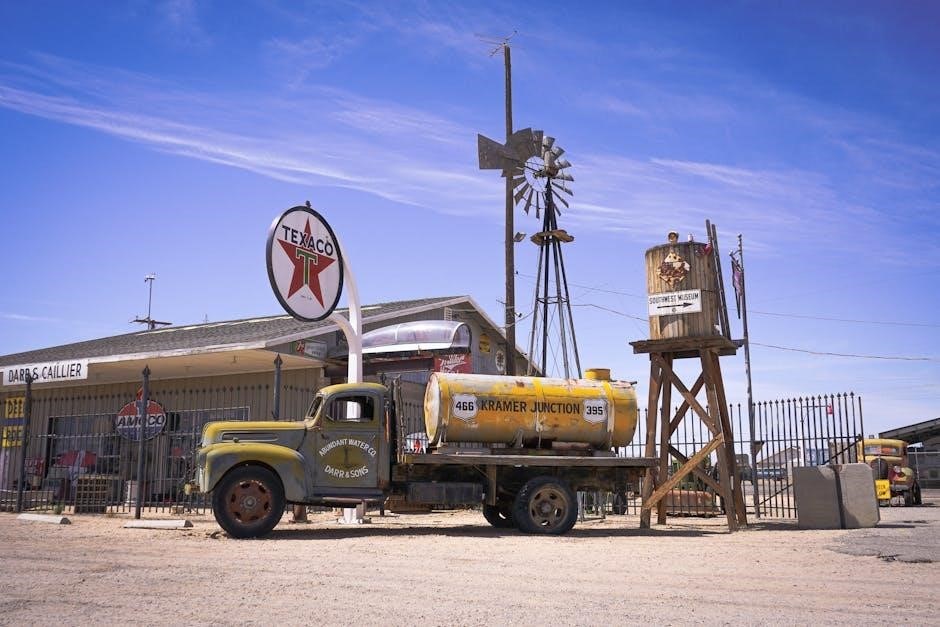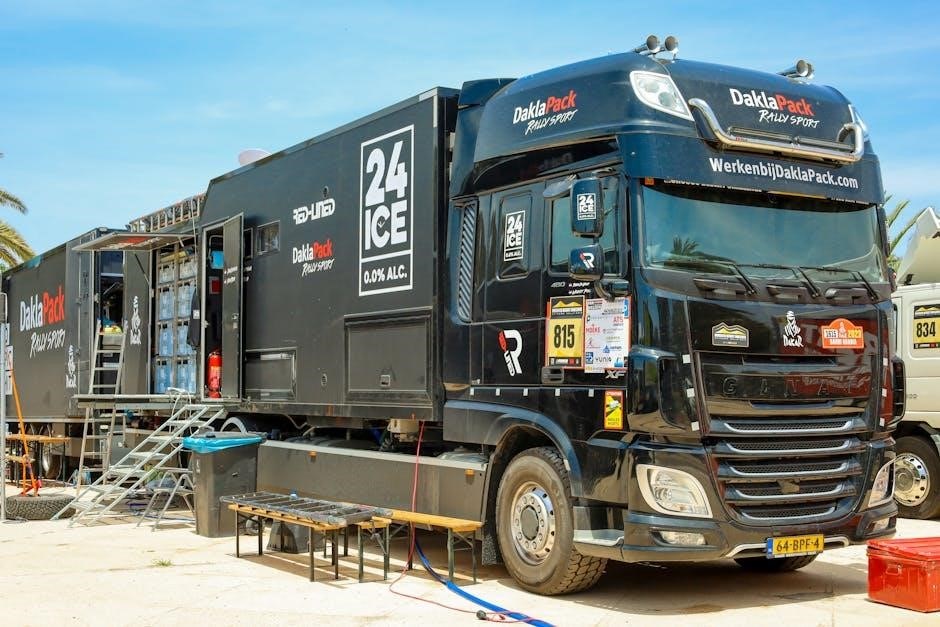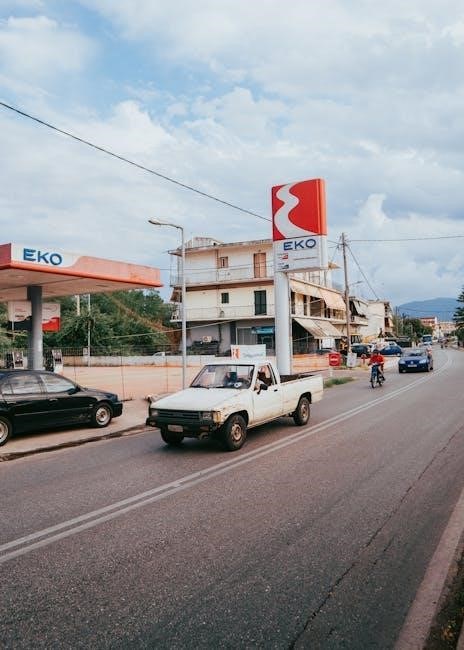Fuel tanker truck specifications pdf documents outline requirements for safe transportation of fuels, including materials and capacities, with
- key points
and
- guidelines
for operators and manufacturers always.
Overview of Fuel Tanker Trucks
Fuel tanker trucks are specialized vehicles designed to transport large quantities of fuels, including gas, diesel, and jet fuel, with specifications outlined in fuel tanker truck specifications pdf documents, which provide a comprehensive guide for manufacturers and operators, including details on tank materials, capacities, and safety features, to ensure the safe and efficient transportation of fuels, and these vehicles play a critical role in various industries, including aviation, transportation, and energy, and are used to refuel aircraft, vehicles, and equipment, with different types of fuel tanker trucks available, including rigid and articulated trucks, and trailers, each with its own unique characteristics and advantages, and fuel tanker truck specifications pdf documents provide valuable information on these vehicles.
Types of Fuel Tanker Trucks
Fuel tanker truck specifications pdf documents categorize fuel tanker trucks into various types, including rigid, articulated, and trailer-based trucks, with each type designed for specific applications and industries, such as aviation, transportation, and energy, and these vehicles are further classified based on their tank capacities, materials, and safety features, with some fuel tanker trucks designed for transporting specific types of fuels, such as gasoline, diesel, or jet fuel, and others designed for transporting multiple types of fuels, and fuel tanker truck specifications pdf documents provide detailed information on the different types of fuel tanker trucks, including their design, construction, and operational characteristics, and these documents are essential for manufacturers, operators, and regulatory agencies, to ensure the safe and efficient transportation of fuels, and to comply with relevant regulations and standards.

Design and Construction of Fuel Tanker Trucks
Fuel tanker trucks are designed with safety features and durable materials for transporting fuels, using advanced technologies and engineering principles always.
Tank Materials
Fuel tanker truck specifications outline the use of various tank materials, including aluminum, steel, and stainless steel, each with its own unique characteristics and benefits, such as resistance to corrosion and durability. The choice of tank material depends on the type of fuel being transported and the environmental conditions in which the truck will operate. Aluminum is a popular choice for fuel tankers due to its lightweight and corrosion-resistant properties. Steel tanks are also commonly used, offering a high level of strength and durability. Stainless steel tanks are used for transporting certain types of fuels that require a high level of purity and sanitation. The use of these materials ensures the safe and efficient transportation of fuels, and is an important aspect of fuel tanker truck specifications, with different materials suited to various applications and regulations.
Tank Capacity and Dimensions
Fuel tanker truck specifications pdf documents detail the various tank capacities and dimensions available, ranging from 500 to 12,000 gallons, with different sizes and configurations to suit specific transportation needs. The tank capacity and dimensions are critical factors in determining the overall efficiency and safety of the fuel transportation process. The specifications outline the various tank sizes, including the length, width, and height, as well as the gross vehicle weight and axle load capacities. The tank capacity and dimensions are also influenced by the type of fuel being transported, with different fuels requiring specific tank sizes and configurations to ensure safe and efficient transportation, and to comply with relevant regulations and standards for fuel tanker trucks, with a focus on safety and efficiency.

Regulations and Certifications
Regulations govern fuel tanker truck operations, with compliance and certification requirements always.
DOT-406 Regulations
The Department of Transportation (DOT) regulates fuel tanker trucks through the DOT-406 regulations, which outline specific requirements for the design, construction, and operation of these vehicles. The regulations cover aspects such as tank material, size, and configuration, as well as safety features like emergency valves and pressure relief devices. Fuel tanker trucks must meet these regulations to ensure safe transportation of fuels and compliance with federal laws. The DOT-406 regulations are enforced by the Federal Motor Carrier Safety Administration (FMCSA) and are an essential part of the fuel tanker truck specifications pdf. By following these regulations, manufacturers and operators can ensure that their vehicles meet the necessary safety standards, reducing the risk of accidents and protecting the environment. The regulations are regularly updated to reflect changes in technology and industry best practices.
ADR and EN14025 Certifications
The ADR and EN14025 certifications are essential for fuel tanker trucks operating in European countries, ensuring compliance with strict safety and environmental standards. The certifications cover aspects such as tank design, material, and construction, as well as safety equipment and operational procedures. Fuel tanker trucks must meet the requirements outlined in the ADR agreement and EN14025 standard to obtain certification. The certification process involves a series of tests and inspections to verify compliance with the regulations. The ADR and EN14025 certifications are recognized internationally and are often required for fuel tanker trucks to operate in certain regions. By obtaining these certifications, manufacturers and operators can demonstrate their commitment to safety and environmental responsibility, and ensure that their vehicles meet the necessary standards. The certifications are an important part of the fuel tanker truck specifications pdf, providing a framework for safe and responsible operation.

Features and Options
Options include tank floor choices and baffle openings with
- various
configurations always available.
Tank Floor Options
Tank floor options are available to suit different needs, with 1/4, 5/16 or 3/8 tank floor options providing varying levels of strength and durability. The choice of tank floor option depends on the type of fuel being transported and the operating conditions. A stronger tank floor may be required for transporting heavier fuels or for operating in harsh environments. The tank floor options are designed to provide a safe and reliable means of transporting fuels, with features such as crossmembers at all heads and baffles to prevent sloshing and ensure stable transportation. The options include offset baffle openings to prevent sloshing and ensure safe transportation of fuels. The tank floor options are an important consideration in the design and specification of fuel tanker trucks. Various configurations are available to meet specific requirements and needs.
Baffle Openings and Crossmembers
Baffle openings and crossmembers are critical components of fuel tanker truck design, playing a crucial role in preventing sloshing and ensuring stable transportation of fuels. The baffle openings are offset to prevent sloshing, while crossmembers are located at all heads and baffles to provide additional strength and support. This design feature helps to reduce the risk of accidents and ensures the safe transportation of fuels. The crossmembers also help to maintain the structural integrity of the tank, even in harsh operating conditions. By incorporating baffle openings and crossmembers, fuel tanker truck manufacturers can provide a safe and reliable means of transporting fuels. The design and specification of these components are carefully considered to meet the requirements of fuel tanker truck operations. Various configurations are available to meet specific needs and requirements. Proper design is essential for safe operation.

Operation and Maintenance
Fuel tanker trucks require regular checks and servicing to ensure optimal operation always.
Ground Level Operation
Fuel tanker trucks are designed to provide ground level operation, allowing for safe and efficient loading and unloading of fuel. This feature is particularly important for reducing the risk of accidents and injuries. The ground level operation also enables easier maintenance and inspection of the truck’s components, such as the tank and pumps. Additionally, it provides a more stable and secure platform for operators to work on, which is essential for ensuring the safe handling of fuels. With ground level operation, fuel tanker trucks can be operated with greater ease and convenience, making them a vital component of the fuel transportation industry. The design and functionality of ground level operation vary depending on the manufacturer and model of the truck, but the overall goal is to provide a safe and efficient operating experience.
Certification and Specification
Certification and specification of fuel tanker trucks are crucial for ensuring compliance with regulations and standards. The trucks must meet specific requirements outlined in documents such as the fuel tanker truck specifications pdf. These specifications cover various aspects, including tank materials, capacity, and safety features. The certification process involves verifying that the truck meets these specifications and standards, such as DOT-406 regulations. The specification document provides detailed information on the truck’s design, construction, and performance. It also outlines the testing and inspection procedures to ensure that the truck is safe for operation. By adhering to these specifications and certifications, manufacturers and operators can ensure that their fuel tanker trucks are reliable, efficient, and safe for use. This is essential for preventing accidents and protecting the environment. Proper certification and specification are vital for the fuel transportation industry.
